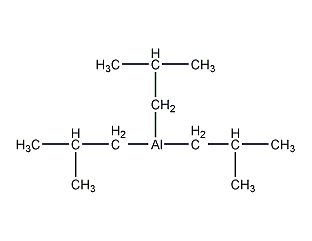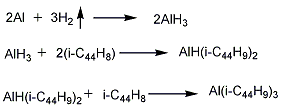
Structural formula
| Business number | 02JY |
|---|---|
| Molecular formula | C12H27Al |
| Molecular weight | 198.32 |
| label |
Tris(2-methylpropyl)aluminum, Triisobutylaluminum, tri(2-methylethyl)aluminum, Aluminumtriisobutanide, TIBA, polymerization catalyst, high energy raw materials, reducing agent |
Numbering system
CAS number:100-99-2
MDL number:MFCD00008929
EINECS number:202-906-3
RTECS number:BD2203500
BRN number:3587328
PubChem number:24855573
Physical property data
1. Properties: Colorless clear liquid with a strong musty smell. Can spontaneously ignite in air. [1]
2. Melting point (℃): -5.6[2]
3. Boiling point (℃): 86 (1.33kPa) [3]
4. Relative density (water = 1): 0.786[4]
5. Saturated vapor pressure (kPa): 0.13 (47℃)[5]
6. Heat of combustion (kJ/mol): -8493.1[6]
7. Critical pressure (MPa): 1.76[7]
8. Octanol/water partition coefficient: 6.17[ 8]
9. Flash point (℃): -23 (CC) [9]
10. Ignition temperature (℃) ):<4[10]
11. Solubility: soluble in benzene. [11]
Toxicological data
1. Acute toxicity No data available
2. Irritation No data available
3. Others[12]
LDLo: 4g/kg (rat oral)
LCLo: 8000ppm (rat inhalation)
p>
Ecological data
General remarks
Water hazard class 1 (German regulations) (self-assessment via list) The substance is slightly hazardous to water.
Do not allow undiluted or large amounts of product to come into contact with groundwater, waterways or sewage systems.
Do not discharge materials into the surrounding environment without government permission.
Molecular structure data
None yet
Compute chemical data
1. Reference value for hydrophobic parameter calculation (XlogP): None
2. Number of hydrogen bond donors: 0
3. Number of hydrogen bond acceptors: 0
4. Number of rotatable chemical bonds: 6
5. Number of tautomers: none
6. Topological molecule polar surface area 0
7. Number of heavy atoms: 13
8. Surface charge: 0
9. Complexity: 92.5
10. Number of isotope atoms: 0
11. Determine the number of atomic stereocenters: 0
12. Uncertain number of atomic stereocenters: 0
13. Determine the number of chemical bond stereocenters: 0
14. Number of uncertain chemical bond stereocenters: 0
15. Number of covalent bond units: 1
Properties and stability
1. Avoid heat and contact with air. Avoid contact with strong oxidants and acids��Contact with water, air, oxygen, alcohol.
2. It is highly irritating and corrosive, and is extremely reactive in nature. It will spontaneously ignite when exposed to air, and will react strongly and explode when exposed to water, acid, alcohol, and ammonia. The chemical reactivity is very high and it will smoke and ignite spontaneously when exposed to air. It is extremely sensitive to trace amounts of oxygen and moisture and can easily cause combustion and explosion. It can react with oxidants. It decomposes strongly when exposed to water and releases flammable alkane gas. Decomposes violently when exposed to high temperatures.
Storage method
Storage Precautions[13] It must be packed in inert gas or special containers during storage. Store in a cool, well-ventilated special warehouse, away from fire and heat sources. The storage temperature does not exceed 30°C and the relative humidity does not exceed 80%. The packaging must be sealed and must not come into contact with air. They should be stored separately from oxidants, acids, alcohols, etc. and avoid mixed storage. Use explosion-proof lighting and ventilation facilities. It is prohibited to use mechanical equipment and tools that are prone to sparks. The storage area should be equipped with emergency release equipment and suitable containment materials.
Synthesis method
1. Aluminum powder, hydrogen and isobutylene are directly synthesized in the next step under the conditions of 110~120℃ and 5~6MPa to prepare this product. It is more advantageous if pre-prepared triisobutylaluminum is added during the reaction. The reaction product is left to settle, centrifuged, filtered, and prepared to become the finished product. 
2. Use activated aluminum powder, isobutylene and hydrogen at high temperature and high pressure It is synthesized under low temperature (110~120℃ and 5~6MPa). The reaction product is the finished product after precipitation, centrifugal separation, filtration and preparation.
Purpose
1. Used as polymerization catalyst for butadiene rubber, synthetic resin, synthetic fiber and olefin polymer. It is also used as an intermediate for organometallic compounds and as a high-energy raw material and reducing agent for jet engine ignition systems.
2. Used as a catalyst for organic synthesis and polymerization of olefins. [14]

 微信扫一扫打赏
微信扫一扫打赏

